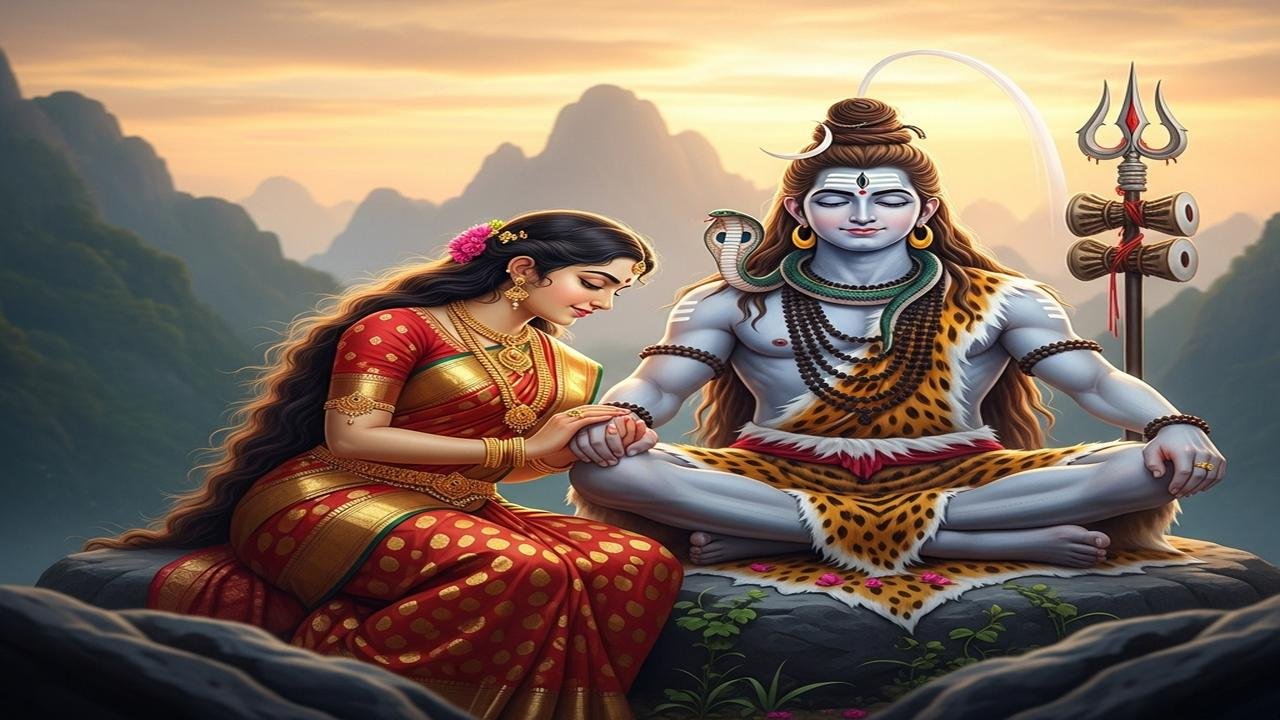Shiva and Parvati: The Purusha and Prakriti Union

Many stories, one ritual image
The marriage of Shiva and Parvati appears across Puranic narratives and classical poetry.
In the Shiva Purana, Skanda Purana and the epic poem Kumarasambhava, Parvati — daughter of Himavat, the mountain — performs tapasya (austerity) to win Shiva’s attention.
Different tellings emphasise different moments: Parvati’s perseverance, Shiva’s aloofness, the wedding ceremony, and the birth of their children such as Skanda (Kartikeya) and Ganesha.
Textual and sectarian perspectives
In Śaiva texts, Shiva is often described as pure consciousness, the static witness of reality.
Shakta traditions place Shakti, the dynamic creative power, at the centre and read Parvati as the active principle that manifests the universe.
Smārta and Vaiṣṇava commentators typically harmonise these views, treating the couple as complementary manifestations of one divine reality.
The cosmological reading: purusha and prakriti
At a basic philosophical level, the marriage represents the union of purusha — consciousness — and prakriti — material nature.
Shiva stands for stillness and awareness, while Parvati embodies movement and creative energy, commonly called Shakti (power).
Their union is therefore the ontological condition for manifestation: without consciousness there is no witness, and without energy there is no world.
What this union signifies in practice
- Creation as cooperation: Reality emerges when awareness and energy meet, not from a single active force.
- Balance of opposites: The myth models how apparent opposites — action and non-action, worldliness and renunciation — coexist.
- Human aspiration: Spiritual life seeks the same equilibrium — clarity of mind together with engaged, ethical action.
Tantric and symbolic layers
Tantric readings treat the marriage as both cosmological and experiential. Rituals and texts describe the union as internalized practices leading to spiritual awakening.
Maithuna (ritual union) appears symbolically in some texts as a method to integrate polarities within the practitioner’s body and mind.
Tantric manuals and commentators caution that such practices are technical and require guidance; they are not mere eroticism.
Ardhanarishvara: visual theology
The Ardhanarishvara icon — half Shiva, half Parvati — condenses the marriage into a single image.
This form expresses non-duality: the divine contains both male and female principles inseparably.
Psychological and ethical interpretations
Psychologically, the couple models integration of conscious awareness with emotional and embodied life.
Parvati’s tapasya (austerity) is often read as inner work: sustained intention and discipline to transform desire into insight.
Ethically, their marriage offers a template for relationships where mutual respect and complementary roles support household duties and spiritual growth.
Householder and renunciate: two ways reconciled
Shiva personifies ascetic freedom, while Parvati restores social and familial life through marriage.
The narrative reconciles the sannyasa (renunciate) ideal with the grihastha (householder) duty, a tension present in Indian religious life.
Different communities emphasise one aspect over another, but many traditions accept both as legitimate stages.
Ritual celebration and living traditions
Temples across India celebrate the marriage through kalyanotsava (marriage festivals), often attracting large congregations.
Mahashivaratri is commonly observed as a night of vigil connecting to Shiva’s power and the union motif, though local calendars vary.
Folk enactments, temple dramas and tantric rites keep multiple layers of meaning alive in everyday devotional practice.
Cautions and scholarly humility
Interpretation varies widely across regions, scriptures and lineages, and no single reading exhausts the motif’s richness.
Tantric practices mentioned in some accounts may involve breathwork or taboo rites; such methods require expert guidance and medical caution.
Why the marriage still matters
The Shiva–Parvati marriage functions on many registers: cosmological, psychological, social and ritual.
It teaches that the sacred is not solely transcendence or immanence but their ongoing interplay.
For devotees and scholars alike, the story remains a resource for thinking about balance, agency and the transformation of desire into wisdom.
Note: This article summarises common readings and highlights interpretive differences across traditions. Where specific practices are involved, consult knowledgeable teachers and consider health precautions before attempting breathwork or intensive austerities.
